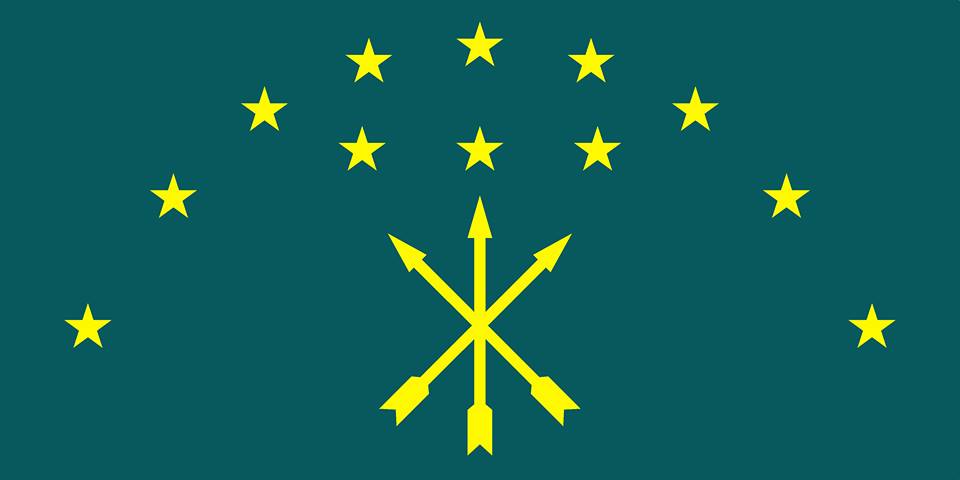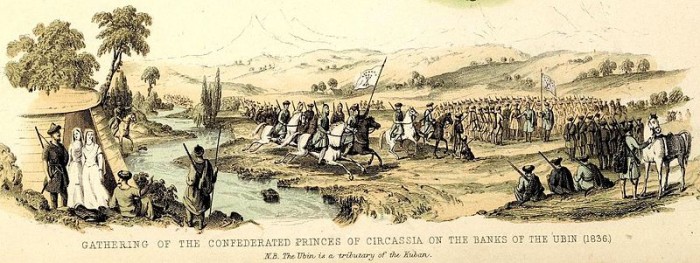A Closer Look At Circassia
By: Adel Bashqawi
October 8, 2020
Abstract
The passage of time has not and will not lead to the loss of the Circassian Question of its momentum and importance in various aspects. While the elements that have affected the composition and shaping of the scene since the early historical ages and the history of the formation of one of the indigenous human entities in their Caucasus cradle of Civilization still exist.
The development of the nation as part of the human fabric in such a strategic area with great importance has been marred by many negative influences and interruptions as a result of the difficult status and conditions imposed by colonial ambitions that wanted to finish off and sparse this nation outside its homeland.
The passage of more than a century and a half since the deportation of the vast majority of the nation and the distribution of the rest of them in several tiny, divided parts and administrative areas of their historical homeland, is still the status and fate of this nation that needs to be able to restore its legitimate rights.
Introduction
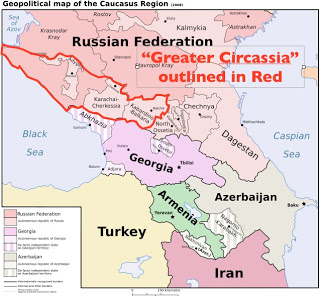
Circassia is one of the main nations of the Caucasus region, located to the North-northeast of the Black Sea. Historic Circassia has undergone administrative, geographical and demographic transformations and changes since it was invaded and occupied. However, it “is situated within the Caucasus Plateau and is considered a natural obstacle. It contains Mount Elbrus, the highest peak in Europe, with an elevation of 18,510 feet above sea level. The Circassian homeland is in southeastern Europe. It is in a strategic area situated in the northwestern part of the Caucasus mountain range. It lies on the northeastern shores of the Black Sea, extending between the Sea of Azov and Abkhazia.” [1]
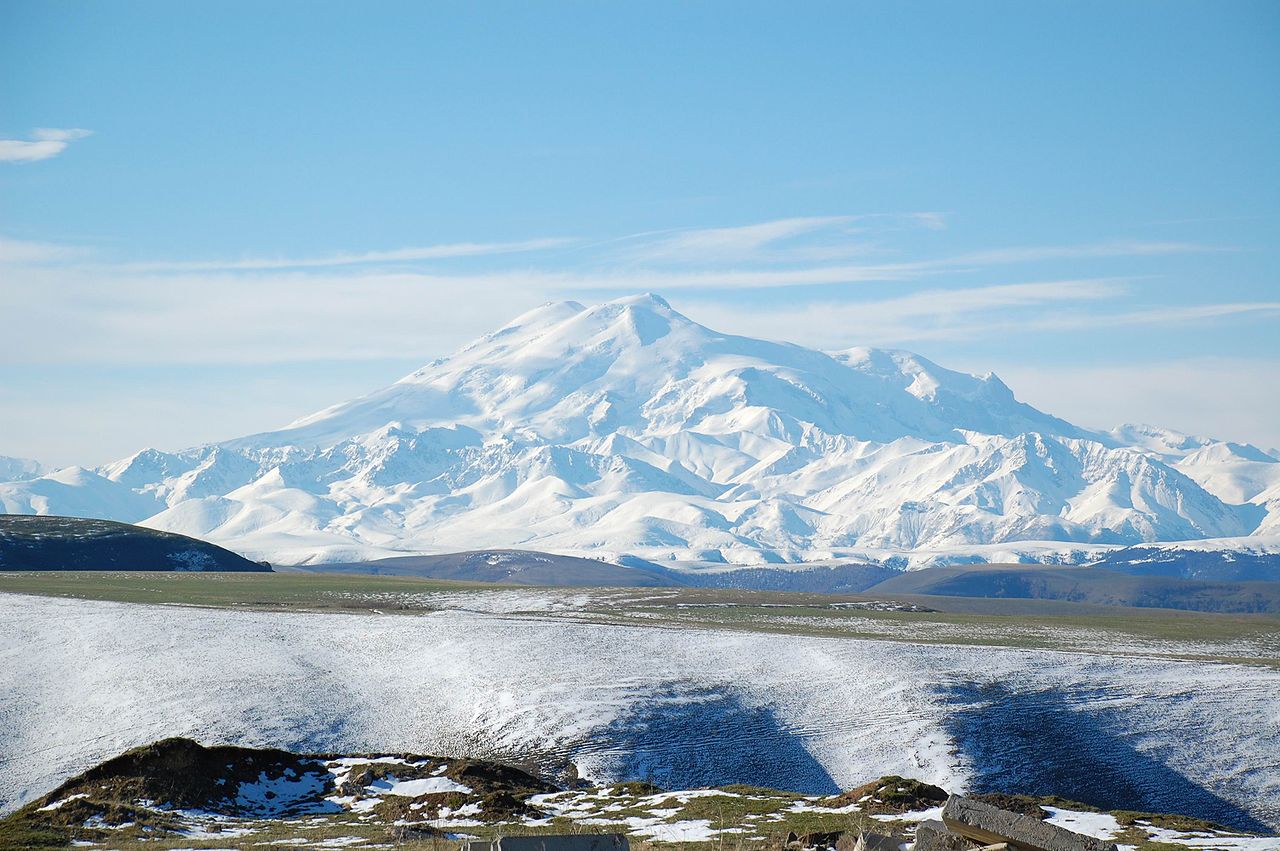
Furthermore, “Circassia was not born out of circumstances, whims, or fantasies, nor was it built by conquering the innocent and oppressed. It is known in history as the homeland of the indigenous Circassian people who participated in the process of the advancement of human civilization. Circassians had to endure a high cost of self-preservation and existence as one of the nations of the Caucasus while being identified by their distinctive homeland.” [2]
Famous author Walter Richmond wrote in his book, the Circassian Genocide: “Circassia was a small independent nation on the northeastern shore of the Black Sea. For no reason other than ethnic hatred, over the course of hundreds of raids the Russians drove the Circassians from their homeland and deported them to the Ottoman Empire. At least 600,000 people lost their lives to massacre, starvation, and the elements while hundreds of thousands more were forced to leave their homeland. By 1864, three-fourths of the population was annihilated, and the Circassians had become one of the first stateless peoples in modern history.” [3]
The Circassian Nation being Part of the Caucasus
The Circassians, being a European nation were throughout the ages, the indigenous inhabitants of the Northwestern Caucasus, had lived in the same region, which confirms their existence since the earliest agriculture and the beginning of metal tool-making age. After the fifteenth century, Circassians consisted of 12 tribes that are represented on their aquamarine green flag by twelve golden stars beside three crossed arrows that symbolize union and peace. Their status was witnessed during the nineteenth century by “John Augustus Longworth.” [4] They were commonly called by others Circassians or Cherkess, as the name was designated by the Greeks, Turks or Russians; but their self-designated name and language is called Adygha.
Who are the Circassians

The Circassian nation is one of the oldest indigenous nations not only in the Caucasus but in the world. “The Circassian people which is one of the oldest nations existing today. Our knowledge is mostly based on traditions, legends, old songs, and narrations, which preserved some of the events of the past.” [5]
“The Circassians are the original inhabitants of the northwestern Caucasus: ‘An agricultural and cattle-breeding culture arose in the Northwest Caucasus in the early Bronze Age. By 3,000 B.C., the Dolmen culture, whose name comes from the distinctive megaliths used as grave markers, had arisen here and reached its peak; it lasted until the last quarter of the second millennium B.C.’” [6]
“The Circassians had suffered the invasions of the Huns, Mongols, and Tatars, to name but few; however, in each case, the hardy natives managed to escape the worst by either taking refuge in the mountains and then striking back under favorable circumstances, or by peacefully, co-existing with the newcomers and eventually assimilating them.” [7] Unluckily, irony of fate drove the destiny of the Circassian nation to an abyss that wasn’t easy to avoid.
“The native self-designation was first recorded in the fifth century BC. It was explained by some Circassian scholars as a corruption of an older term ‘Antixe’, the Ants being people thought to be ancestral to the Adiga, and -xe the plural suffix.” [8]
“The first mention of the name Circassia was made by John de Plano Carpini, Pope Innocent lV’s envoy to the Great Khan of the Mongols, who made his journey in 1245 AD (M. de Avezac, 1839, p776). According to him, the Circassians were Christians at the time.” [9]
Prince Inal (Yanal in Circassian) was one of the greatest known circassian kings. He was born in 1370 and passed away at the age of eighty-three years old. He was “called Inal the Great by Georgian sources.” He is described as “medieval Circassian prince of the Kabarday tribe who took the sovereign power, or authority in the Kabardia region of Circassia in the 15th century and had taken as his goal to unify all of the Circassians who were divided into several tribes into one state. Each Circassian tribe maintained a distinct region in Circassia and had a ruling class of their own.” [10]
The Evolution of Naming Circassians
In old times and in different periods of history the Circassians appeared under different names which designated only some of their tribes; these names should be properly identified and described to avoid confusion. The ancient Greeks knew the ancestors of the Circassians under the name Zych and Kerket, which designated two different tribes of the Circassian people.
They demographically developed into different tribes, and their names changed over time. “The Georgian chroniclers called them Djik (which is the same as Zach), and their country Djiketia. However, the author of the Derband-nameh called all people dwelling between the Terek River and the Black Sea “Djuli-and”, referring to the Ants, bearing in mind that all those countries have been always inhabited by the different Circassian tribes.” [11]
It is important to know the development of relations between the peoples of the Caucasus throughout history, through the name and description given to them and to know some facts related to their life. “According to the traditions of the Ossets, the Circassians were referred to by the Mingrelians as ‘Kazakh’ and their princes ‘Kazach-mepe’ that means ‘Kings of the Kazakhs’, until the arrival of the Kabardian princes from the Crim. This statement also coincides with the account of the Emperor Constantinus Prophyrogeneta who called the country of the Circassians on the Black Sea ‘Zychia’ and that adjoining the country of the Alans ‘Kazakhia’.
And at the time of George Interiano (about 1502) the Circassians occupied all countries lying about the sea of Azov, and their territories extended from the Don River to the Cimmerian Bosphorus.” [12]
Shauket Mufti mentioned the origin and and part of the evolution of naming the Circassians as such. “The traditional and historical name of the Circassian people is Nat or Nart which is preserved in poesy, narrations and popular traditions which include the following:
a) In the Derbend-Nameh the country of the Circassians is referred to as Djuli-And.
b) Furthermore Strabo, who wrote in 26 B.C., also calls the KubanRiver Antikita (Anticites).
c) The map of Lapie, designed according to Ptolomaeus and Plinius, shows the name Anticate, referring to the Ants, on both banks of the Cuban River, at its confluence with the Laba River.” [13]
Circassians’ Religion
“Historically the Circassian religion is confined to three important phases: the pagan, the Christian and the Moslim. Each of these phases left its effect on Circassian customs and traditions, and many religious teachings eventually became national customs and traditions after the people had forgotten the origin of such customs. In ancient times they worshiped the various natural powers, especially the sun and the trees; they had holy gardens and forests … People assembled in these holy forests in order to say their prayers and invocations.” [14]
“The Adighes were won over to Christianity during the reign of Emperor Justinian in the 6th century A.D. Consequently relations were strengthened between our nation and the great Byzantine Empire. Justinian directed his efforts towards his allies, the Adighes, who met his good feelings with such obedience, loyalty and respect him.”
“It was during the reign of Justinian that the historic buildings and ancient churches still existing in Circassia were built, a fact which shows that the Circassians had at that time a degree of culture and art and that when the new arch movement arose they began to work immediately in the fine arts and crafts that accompanied it.” [15]
“The Adighes did not adopt Islam as one body or at onetime, and what has been said applies to the Kabardians only. As to the tribes living in the cuban and on the eastern coasts of the Black sea they did not become Moslims until the 19th Century, i.e.till before the exodus of 1864. It seems that they adopted Islam when they despaired of being assisted by the European powers in their flight against the Russians and needed Ottoman assistance. They were converted to islam by the followers of Imam Shamil and his deputy Muhammad Amin who exerted great efforts to win them over the new faith.” [16]
Embracing the Islamic religion in Circassia and the North Caucasus, and the degree of religiosity among Circassians was according to the various regions. “Their adherence to Islam varied significantly–from the northeast Caucasus where Islam was deeply entrenched among the peoples of northern Dagestan and Chechnya, to the north-central Caucasus where Islam held a far more tenuous hold over Kabardinia (the eastern Adygeia) and Ossetia, and to the north-west Caucasus where Islam was often nominally accepted by the western Adyge peoples, more popularly known as the Circassians.” [17]
Küçük Kaynarca and Adrianople Treaties
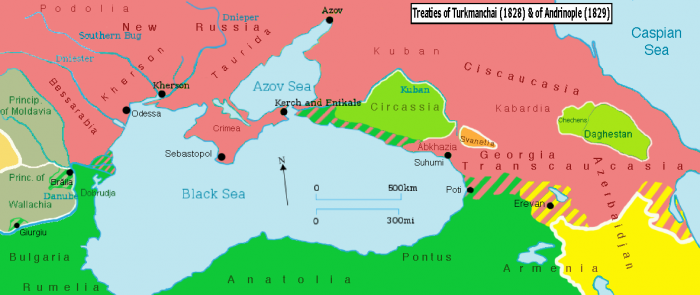
Among the large countries that bear direct moral and legal responsibility, and were competing among themselves in the Black Sea Coast and the Caucasus region in the eighteenth and nineteenth centuries, are the Ottoman and the Russian Empires. It is no accident that nations’ rights are trampled on, the events are distorted, and history is falsified by imposing ready made scripts and formulas in a way that appeals for one party or another.
Perhaps the “Treaty of Küçük Kaynarca” was the beginning of acquiescence, decline, weakness of will, and the potential disintegration of the aging Ottoman Empire. At the same time, the Russian Tsarist Empire took advantage of all the colonial spoils and imperial influence lost as a result of the weakened and aged Ottomans. The pact was signed on July 21, 1774. “At the conclusion of the Russo-Turkish War of 1768–74 at Küçük Kaynarca, in Bulgaria, ending Undisputed Ottoman control of the Black Sea and providing a diplomatic basis for future Russian intervention in internal affairs of the Ottoman Empire.” [18] The “treaty was a most humiliating blow to the once-mighty Ottoman realm. It would also stand to foreshadow several future conflicts to arise between the Ottomans and Russia. This would be only one of many attempts by Russia to gain control of Ottoman territory.” [19]
Another important milestone of Ottoman collapse, which indicated the inevitable end of the Ottoman Empire and its uncontrolled decline, is the Treaty of Edirne, also called Treaty of Adrianople. Signed on September 14, 1829, it is the “pact concluding the Russo-Turkish War of 1828–29, signed at Edirne (ancient Adrianople), Tur.; it strengthened the Russian position in Eastern Europe and weakened that of the Ottoman Empire. The treaty foreshadowed the Ottoman Empire’s future dependence on the European balance of power and also presaged the eventual dismemberment of its Balkan possessions.” [20]
The Circassians were set up to be destroyed and eliminated by the irresponsible actions of others. “Russia, victorious on the Balkan and Caucasus fronts, preferred a weakened Ottoman Empire to one that was dismembered by other powers. The treaty allowed Russia to annex the islands controlling the mouth of the Danube River and the Caucasus coastal strip of the Black Sea, including the fortresses of Anapa and Poti.” [21]
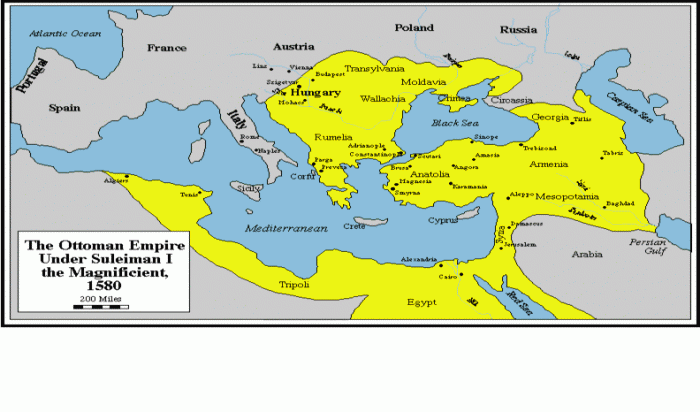
Shameless frankness concluded the farce of giving up the homeland of others, regardless of all consequences, through a swap of colonial interests between those who do not own to those who do not deserve. “It gave Russia, as the victors, Item (b) of Treaty of (Edirne) Adrianople (1829) states: Control of the Caucasus coastal strip by annexation of considerable territory in the Caucasus.” [22]
The Russian-Circassian War
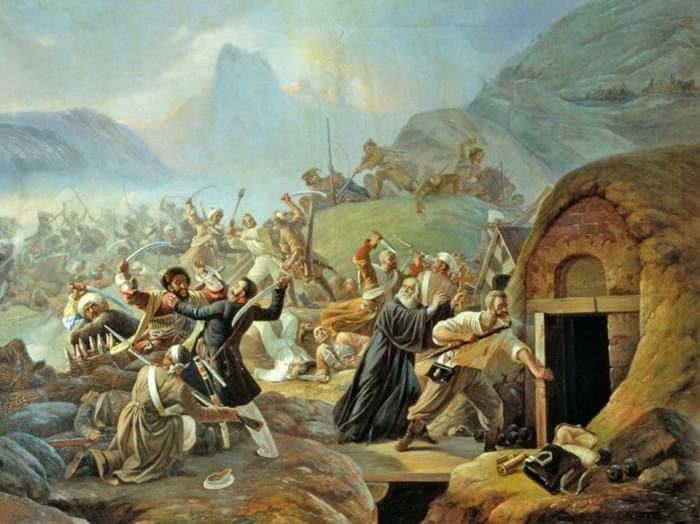
“The Russian-Circassian War was not an improvised or contingent event, but a predetermined and well-planned project. It was built upon an edifice of tsarist imperialism, a forthcoming entity built upon the ruins of small nations through destructive colonial wars. The Muscovites and their descendants had inherited the desire to control others’ homelands from their ancestors who preceded them in this.” [23]
“Russian colonial policies did not emerge from nothing. Predetermined colonial intentions pushed the preliminary steps that led to the occurrence of the Russian-Circassian War, which lasted for 101 years and led to the fall of innocent victims and positioned Circassians in unprecedented disastrous consequences.” [24]
“Dozens of nations were victims of tsarist Russian wars, invasion, destruction, occupation, maltreatment, atrocities, murder, displacement, ethnic cleansing, and genocide. Colonialism and direct autocracy were always mired with racism that goes in line with apartheid. By use of force and after the total occupation of their homeland in May of 1864, 10 percent of the Circassians ended up as a minority in their own homeland and 90 percent had to emigrate and be deported to the Ottoman Empire, which ended up as minority communities in Turkey, Syria, Jordan, Israel, Europe, the United States, and thirty other countries around the world.” [25]
“Terror, intimidation, and bullying were the well-known means used, along with a propaganda war on the Circassians by the Russian Empire’s armed forces and mercenaries.” [26]
During the war, many European newspapers and journals had an echo of enthusiasm and realism to address the consequences of the Russian murder and annihilation war against the Circassian nation.
I cannot fail to mention in this scope, the coverage of the tragedy of the Circassian People in contemporary Georgian public thought during the nineteenth century. The catastrophe and its grave outcome befall the Circassians, has “found heartfelt sympathy on the part of progressive representatives of Georgian public of the time.” Also, to mention that “the Georgian print media of the 1860s-90s was particularly active.” This confirms the cohesion of the peoples of the Caucasus and the felt yearning for freedom and liberation from foreign domination.
“The stance of Georgian society was overtly stated in the Georgian print media of the time. Georgian newspapers rather intensively published articles about freedom-loving Circassians, about the tactics of their heroic struggle, Muhajirism, and the essence of Russia’s colonizing politics. When reading these articles, one can see how painfully Georgians perceived the misfortunes of the mountaineers, having been expelled from their native lands. The newspapers ‘Droeba’ (‘Times’), 9 edited by Sergei Meskhi, ‘Iveria’,10 edited by Ilia Chavchavadze, also ‘Kvali’ (‘Footprint’), 11 and others were particularly keen on the problem of Muhajirism of mountaineers.” [27]
The tsarist Russian Empire had started its 101-year-long devastating war that is characterized by its disproportionality in troops and weapons used to expand its boundaries into the Black Sea coastline and ports of what used to be called Circassia. [28]
The Circassian Independence
“Throughout imperial history, occupying and colonizing authorities assumed domination and practices of absolute rule and power to change the realities, features, and landmarks in all walks of life of the colonized nations. Aiming to the furthest extent possible, they wanted to exclude the indigenous people from bearing the responsibility of governing themselves. Unless subjugated nations oppose such authoritarian policies, they will eventually force and compel the greedy and covetous state to comply with their ambitions of freedom to choose their own destiny that necessarily would lead to assume legitimate rights of self-determination, freedom, and independence.” [29]
“The Independence is not something never experienced for the Circassians.” During the Russian-Circassian War (1763-1864), the confederated princes of Circassia, gathered on the banks of the Ubin River in 1836, had declared the Independence of Circassia, which was addressed to the courts of Europe, and consequently, was published in the main European journals and newspapers. Regrettably, “Europe ignored the brutality of Russia against the Circassian people struggling for survival.” [30]
In 1836, a “general meeting of the Khasa was held in (Psefabe) Valley where representatives of the Circassian tribes met,” the Circassian flag was presented. The representatives of the Circassian tribes approved the flag, which was “a piece of green silk material, embroidered in gold thread twelve gold stars and three crossed arrows.” [31]
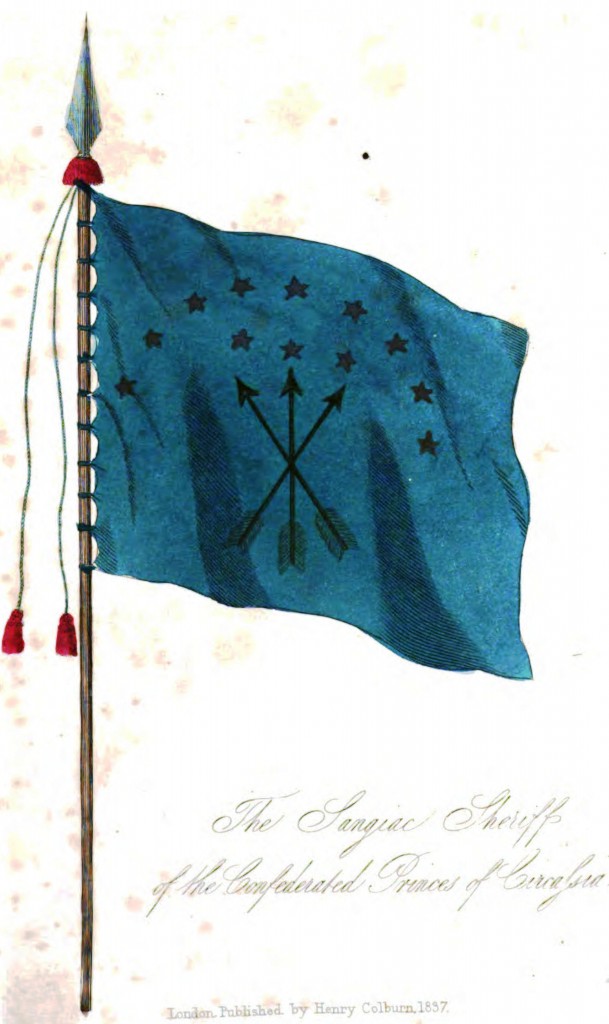
Circassian Genocide, One of the Main Massacres in History
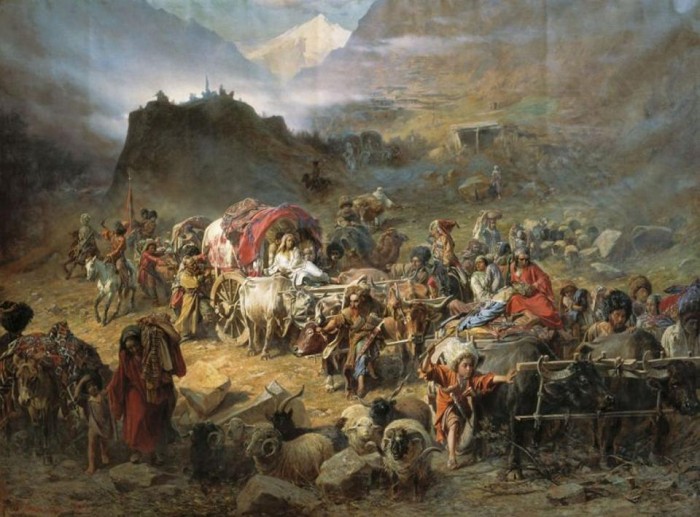
The nineteenth century Circassian Genocide was worst of its kind, which the Russian Empire committed against any other people or nation. “The genocide Russia committed against the Circassian nation was unparalleled in the history of man in methods of brutality, in the scope of the military forces she deployed for that purpose, and in the duration of time she persisted to accomplish it. The Russo-Circassian War … was a part of the process of that genocide. The eviction of the Circassians from their native lands and the settlement of the Cossacks in them, (which was witnessed) during the Russo-Circassian War, was the beginning of the final stage of the completion of that well planned and systematically executed genocide.” [32]
“In September 1861, the Emperor himself, Tsar Alexander II, visited Yekaterinodar, the Russian town closest to the scene of the action, and there received a delegation of Circassian chiefs. The chiefs expressed readiness to recognize Russian suzerainty provided that Russian troops and Cossacks were removed from Circassian lands beyond the Rivers Kuban and Laba. Their proposal was rejected. The Abadzekhs, however, agreed to move to new lands offered them further north (many of the titular people of the Adygei Autonomous Province are their descendants) while the chiefs of the other tribes refused to uproot their people.” [33]
When the Russian invasion picked momentum and the empire wanted to the war to be won at any cost, the Circassians who survive the annihilation and destruction had to choose whether to be displaced to internal territories beyond the Kuban basin or to be deported to the Ottoman Empire. Either way, not good.
“The options presented to the Circassians were limited: get annihilated or be obligated to accept the choice of either leaving the homeland to inland plains or to be deported to the Ottoman Empire. All this was offered, apparently in accordance with public and secret agreements between the great powers at the time.” [34]
The Circassians had a little choice but to adhere to follow the path out of their place of origin. “Turkey—before immigration or deportation—is the blessed Muslims’ land, or the Sultan’s blessed land the owner of half of the world, which represents the true paradise on this earth. Hence, it will be the homeland—the religion or the homeland—the bright dream that is contrary to the resident reality of motherland, where the Tsar and his Generals kidnap the Mountaineer leaders and they drive them to cold Siberia, or where they force the Circassians on move to Kuban barren plains where they are forced to convert their religion and compulsory recruitment into the Tsar’s army, which means total submission to the Tsar’s authority.” [35]
Circassia has proven to be a replete with enormous frequent human tragedies. The eventual outcome, and “after the Russian conquest, ‘Circassia’ and ‘Circassians’ gradually faded from memory, as the country became a scene of desolation and the bulk of the once-mighty nation found itself strewn across Ottoman lands.” [36]
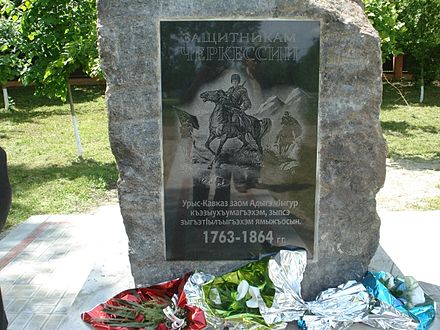
Falsification of History
To falsify the Circassian history and empty the Circassian territories of their antiquities and historical artifacts, in the absence of the legitimate owners of the Circassian homeland. The Russian authorities over the decades seized and acquired all that was extracted from the excavation of antiquities in order to empty the Circassian land of its precious archaeological treasures, and to manipulate the history of the region and fabricate suspicions over the national heritage.
“Russia claims that it brought culture to the wild Circassians, but what does the fact say? Three years after the end of the one hundred year war, in the year 1867 the first expedition of the Russian Academy of Science arrived in Circassia, which by that time was completely depopulated. The digs that were undertaken had stunning results. The ecologists discovered incredible and very valuable examples of an ancient culture. For the next 140 years the excavations had continued. Tens of thousands of artifacts had been found over the 140 years were sent and they are now in various museums in Moscow and St. Petersburg.” [37]
“The cultural inheritance of the Adigas was consistently destroyed during Stalin era. One example: In 1937 simultaneously in all the three republics, about fifty Adiga scientists had been arrested. These linguistics, historians, folklorists, and poets, the majority of them were shot almost instantaneously. All the archives were destroyed and burned. Among those who were shot was a group of scientists who for the first time had collected epos of the Circassian nation. Among the documents that were burned, 20 000 gathered poems, sayings, proverbs, and ethic poems of the Circassians, which had been collected in the thirties of the last Century, and those losses cannot be regained.” [38]
Post Deportation
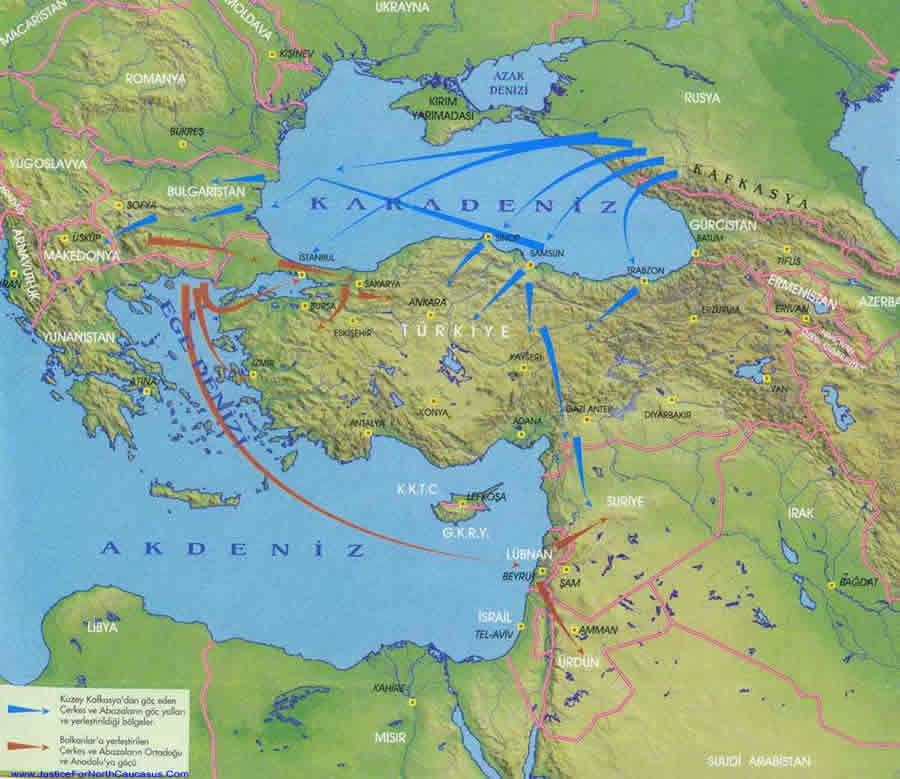
After they were deported from their homeland to the Ottoman Empire, the Russian Empire prevented the return of Circassians to their original homeland. Whoever dared to return, was imposed with harsh penalties, including exile to Siberia. Conditions were not better in the Soviet era, where the Iron Curtain contributed to the interruption of the Circassian Diaspora from communicating with their homeland and their citizens there on the one hand, and to the inability to return to it for those who wanted according to international laws and norms on the other hand.
“About 1,500 Circassians returned to the Caucasus after the collapse of the Soviet Union, including 200 repatriated after they were attacked by ethnic Albanians during the Kosovo war. More recently the Circassians have been in the news when hundreds of them fled their longtime homes in Syria back to Russia to escape the civil war.”
In fact, there are various obstacles and constraints that the current Russian authorities place in, on the way of those wishing to return to their homeland and live there, while they ignore fundamentals of the Universal Declaration of Human Rights and even the Russian laws. [39]
“Today there are about 3 million to 5 million Circassians living abroad and about 700,000 in the Caucasus. The post-Soviet Russian government has been slow to recognize the extent of what happened to the group and has strongly resisted attempts to label it as genocide.” [40]
The So-Called 450-Year Association with Russia (in 2007)

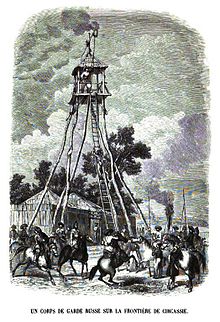
Historical falsehood, falsification, forgery, and lying is not enough to claim or accept a deal between various parties, especially when acquisition of the rights and property of others is the target.
object.
— Ten years later (2018), the same trick is repeated with a different slogan, “the 460 years of Kabardian voluntary association with Russia”!
— Nothing could have been worse, otherwise they would have done it. [41]
Genocide Recognition

A study carried out and presented on May 2011 to the ‘Parliament of Georgia’ by Prof. Merab Chukhua in the title of “Circassian Genocide: The History of Problem, Chronicles of Events, the Scientific Conclusion,” has triggered the ‘Parliament of Georgia’ to recognize the Circassian Genocide.
Depending on the findings of the study, the Parliament passed a resolution that:
“1. Recognizes the mass murder of Circassians (Adyge) during the Russo-Caucasus War and their forceful eviction from their homeland, as an act of genocide, in accordance with the IV Hague Convention on Laws and Customs of War on Land of October 18, 1907 and the UN Convention on the Prevention and Punishment of the Crime of Genocide of 9 December 1948;
2. Recognizes the Circassians, forcefully deported during and after the period of the RussoCaucasus War, as refugees, in line with the Convention on the Status of Refugees of 28 July 1951.” [42]
2014 Sochi Winter Olympic Games
“In the wake of the disintegration of the Soviet Union, the Northwestern Caucasus became an easy prey for the elites and those who control and dominate the Russian State. ‘The Western Caucasus, a wilderness area along the Black Sea shores in Russia’s Krasnodar region includes a UNESCO World Heritage Site and one of the most unique and diverse ecosystems in Europe.’” [43]
This cleared the way for one of the recent euphorias that the Russian authorities have enjoyed was holding the 2014 Sochi Winter Olympic Games in February. Russia determined conclusively to establish the Olympic Village and ski resorts together with all service facilities on the the Circassian genocide site, specifically on the graves of those who perished while defending their homeland, at the end of the Russo-Circassian War in 1864. However, “The Russian authorities and the IOC have left unanswered questions and unsolved issues regarding the controversial Sochi Olympic Games” [44]
All this empowered the Circassians to get certain gains, which is to explain to the world about the Circassian Question and the tragedies that befell the Circassian nation during the war of extermination and deportation from the Circassian homeland. They managed to attain the possibility of informing the world that the last battle in the Russian-Circassian War tool place in the last Circassian capital of Sochi, which ended a brutal war of 101 years.
“In one small but significant development, the governor of Krasnodar province, where the games will take place, acknowledged that ‘This land has not belonged to the Russian Empire, it belonged to Caucasus nations, to Circassians.’ Given the painful memories associated with Sochi, it’s understandable that Circassians have reacted with outrage to the choice of venue. But it also may be the only thing that could have reminded the world of a largely forgotten tragedy.” [45]
Ambassador to Ankara Rants Well-known Russian Policy
Examples have repeatedly proven the extent of Russian intense interests to spread misleading information and false propaganda against the Circassian nation and its eligibility to freedom and dignity, since the outbreak of the Russian-Circassian War in 1763 until now. The Russian Ambassador “referred to the 1864 Circassian Genocide as a ‘wonderful myth.’” [46]
Here is the same colonial and obsessive policy pursued until now in the twenty-first century and in full view of the media outlets, specifically the Russian news agency Sputnik, which conducted a press interview with the Russian ambassador to Turkey. It is not surprising that the misinformation was repeated and the parrots repeat what they learned. Alexei Erkhov, the Russian Ambassador to Ankara, has distorted the history with his words about the voluntary resettlement of Circassians to Turkey during the Caucasian War, Circassian activists assert. [47]
Madina Khakuasheva, a Circassian scholar, Doctor of Philology, senior researcher at the Kabardino-Balkar Institute for Research on the Humanities, published a Study, which was quoted by famous analyst Paul Goble.
“Russia’s approach to the non-Russians has gone through the following stages in the case of the Circassians, Khakuasheva says. ‘First, physical destruction and deportation without the right of return, open discrimination against the native language, leveling of culture and identity, and the complete elimination of the history of the Circassians’ from books and museums. In addition, she continues, Moscow continues to work to create ‘all the conditions for the realization of artificial assimilation and the erasing of all evidence of the existence of an entire people,’ including declaring the territory and resources of those territories Russian ‘{from time immemorial.}’ ‘That is the final goal of geopolitical control.’” [48]
Conclusion
With a mix of racist authoritarianism and colonialism, the Russian consecutive regimes have imposed a unified vile racist policy that is almost without precedent, whether during the Russo-Circassian War or what was committed after by the successive ruling authorities and up to the present day. Who have not tried to deal with the greedy and specious Russian policies’ consequences would neither realize nor comprehend the magnitude of the outcome of the crimes that the invaders committed against an entire nation. They demolished, burnt, occupied, killed, destroyed, cleansed, stole, raped, expelled, and in the end, a total denial of the heinous crimes.
******************
References
[1] Bashqawi, Adel. Circassia: Born to be Free. Page 21
[2] Bashqawi, Adel. Circassia: Born to be Free. Page 22
[3] Bashqawi, Adel. Circassia: Born to be Free. Page 24
[5] Mufti, Shauket. Heroes and Emperors In Circassian History. Page 28
[6] Bashqawi, Adel. Circassia: Born to be Free. Page 22
[7] Jaimoukha, Amjad. The Circassians a handbook. Pages 12/13
[8] Jaimoukha, Amjad. The Circassians a handbook, Pages 11/12
[9] Jaimoukha, Amjad. The Circassians a handbook, Page 12
[10] https://www.geni.com/people/Inal-the-Great/6000000028522706362
[11] Mufti, Shauket. Heroes and Emperors In Circassian History. Page 1
[12] Mufti, Shauket. Heroes and Emperors In Circassian History. Page 6
[13] Mufti, Shauket. Heroes and Emperors In Circassian History. Page 2
[14] Mufti, Shauket. Heroes and Emperors In Circassian History. Page 21
[15] Mufti, Shauket. Heroes and Emperors In Circassian History. Page 22
[16] Mufti, Shauket. Heroes and Emperors In Circassian History. Page 23
[17] https://www.ucis.pitt.edu/nceeer/2008_821-08g_Khodarkovsky.pdf
[18] https://www.britannica.com/event/Treaty-of-Kucuk-Kaynarca
[19] http://self.gutenberg.org/articles/Treaty_of_K%C3%BC%C3%A7%C3%BCk_Kaynarca?View=embedded%27
[20] https://www.britannica.com/event/Treaty-of-Edirne
[21] https://www.britannica.com/event/Treaty-of-Edirne
[22] Paxton, J. Imperial Russia: A Reference Handbook. Page 135
[23] Bashqawi, Adel. Circassia: Born to be Free. Chapter 3 and appendices
[24] Bashqawi, Adel. Circassia: Born to be Free. Chapter 3 and appendices
[25] Bashqawi, Adel. Circassia: Born to be Free. Chapter 3 and appendices
[26] Bashqawi, Adel. Circassia: Born to be Free. Chapter 3 and appendices
[27] http://justicefornorthcaucasus.info/?p=1251662239
[28] Bashqawi, Adel. Circassia: Born to be Free. Chapter 3 and appendices
[29] Bashqawi, Adel. Circassia: Born to be Free. Chapter 3 and appendices
[30] Bashqawi, Adel. Circassia: Born to be Free. Chapter 3 and appendices
[31] Bashqawi, Adel. Circassia: Born to be Free. Chapter 3 and appendices
[32] Natho, Kadir. Circassian History. Page 354
[33] Levene, Mark and Roberts, Penny. The Massacre in History. Page 151
[34] Bashqawi, Adel. The Circassian Miracle. Pages 952/953
[35] Bashqawi, Adel. The Circassian Miracle. Page 953
[36] Jaimoukha, Amjad. The Circassians a handbook, Page 12
[37] http://justicefornorthcaucasus.info/?p=1251681787
[38] http://justicefornorthcaucasus.info/?p=1251681787
[39] https://www.un.org/en/universal-declaration-human-rights/
[41] Bashqawi, Adel. Circassia: Born to be Free. P466
[42] http://www.parliament.ge/files/1544_32742_536746_genocidi-en.pdf
[43] Bashqawi, Adel. The Circassian Miracle. Page 640
[44] Bashqawi, Adel. The Circassian Miracle. Page 641
[47] http://justicefornorthcaucasus.info/?p=1251682188
[48] https://windowoneurasia2.blogspot.com/2020/04/historical-falsification-latest-stage.html
